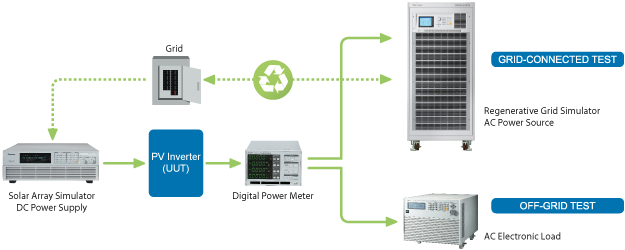PV Inverter Test – Grid-tied, Off-grid, and Hybrid
Published : 2019-04-30 08:26:17
Categories : Mode
A photovoltaic or PV inverter, converts the direct current (DC) output of a solar cell or array into an alternating current (AC) that can be fed directly into the electrical grid (Grid Tie), used by a local electrical grid (Off-Grid), or both (Hybrid Inverters). The PV Inverter is a key component in a photovoltaic system, allowing the use of household and commercial AC powered devices. Solar PV inverters have special functions adapted for use with photovoltaic arrays, including maximum power point tracking (MPPT) and anti-islanding protection.
Our test instrumentation provides means to further the development, reliability, and validation of grid-tied, off-grid, and hybrid solar PV inverters that will eventually be used in commercial and household applications for years to come. We do this by integrating features into our testers that, for example, allow performance testing of inverter behavior during voltage and frequency fluctuations found on the grid. And we can do this either by standalone instrumentation or integrated into an automated test system.

The block diagram shown represents a basic set up for either grid-tied or off-grid PV inverter test.
Grid Tie PV Inverters
An on-grid or grid-connected photovoltaic power system is tied to the local utility mains or grid. They are typically used for residential or commercial applications where any unused power generated is sent to the utility grid where it can be stored and used later. Grid Tie PV Inverters (GTI) are equipped with micro-controllers that synchronizes generated power to the grid. The grid-connecter inverter converts the DC energy collected by the photovoltaic solar panels to AC power which is then either consumed or transferred to the local utility grid. Grid connected PV systems do not require a battery system since the grid provides the on-demand energy.
Off-Grid PV Inverters
An off-grid photovoltaic system allows consumers to have an energy system independent of the utility infrastructure. Power generated by the PV system is either consumed or stored in an on-site battery for later use rather than the grid. Off-Grid Inverters are not designed to sync the generated power to the grid.
Hybrid PV Inverters
Hybrid Off-Grid Inverters (HOG) also known as Grid Tie Inverters with battery backup are an innovative combination of Grid Tie and Off-Grid Inverters.
Maximum Power Point Tracking
Maximum Power Point Tracking (MPPT) is a method used to optimize the amount of energy harvested through a photovoltaic solar system (or other variable sources). A photovoltaic system’s efficiency depends on the amount of power or sunlight collected and transferred to the solar cells. The MPPT is a process that maximizes this energy transfer by finding the point where the solar cells are collecting the most energy thus optimizing the function and efficiency of a photovoltaic system. Moreover, the MPPT filters and distinguishes the most usable power for specific devices or systems by determining the most proper resistance rather than random loads being fed to arbitrary photovoltaic cells. MPPT devices are generally integrated into electric power converter systems.
Anti-Islanding Protection
Anti-islanding protection is a way for the inverter to disconnect itself when it identifies a problem with the power grid so there is no unnecessary power transfer. This safety feature is typically integrated into distributed generators so that all grids can detect islanding (islanding – continually feeding the circuit with power even after shutdown).
